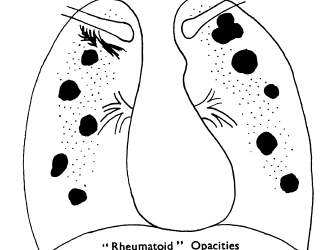
More popularly known as Caplan’s Syndrome, after Dr. Anthony Caplan of the Cardiff Pneumoconiosis Panel, who was the first to describe this condition, this is, as the name suggests, a combination of Rheumatoid Arthritis and Pneumoconiosis.
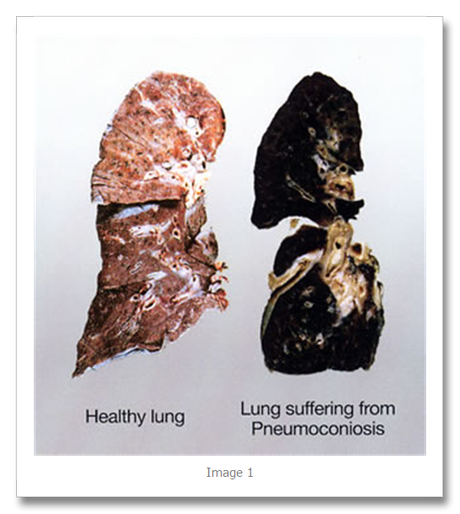
Epidemiology:
With the fall in coal mining industry and the rise of health standards for industrial workers, this disease is more likely to fall than as suggested by historical data. Caplan’s series showed a overwhelming number of patients possibly because his catchment area was South Wales, where both the diseases had an overwhelming presence, leading to an overlap giving rise to his cohort of cases!
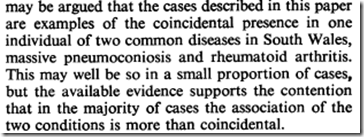
Clinical Presentation:
Patients present with a combination of features of the two offending diseases. Cough and dyspnea due to the Pneumoconiosis and joint features (like arthralgia, morning stiffness, tender/swollen metacarpophalangeal joints, rheumatoid nodules, etc.)
Clinical Rationale & Pathophysiology:
Although this condition seems like the occurrence of two diseases (which are common in certain geographical and occupational settings) coincidentally in the same (rather unlucky) person, there is more to it than just that. Patients with rheumatoid arthritis are prone to suffer from progressive fibrosis of the lungs. Any deleterious insult or injury serves to accelerate the process further.
Hence, anthracosis (or even silicosis), which predisposes to an inflammatory reaction causing scarring of the lungs has a greater potential of manifesting in individuals with underlying rheumatoid arthritis. Silica has immunoadjuvant properties, and is also present in coal dust and is now being increasingly being implicated in the causation of Caplan’s Syndrome.
Histopathology of the nodules is characteristic of the so-called rheumatoid nodule but differs from the typical rheumatoid nodule in that the palisading of fibroblasts in the periphery is less apparent and it is more likely to show the presence of an acute or chronic inflammatory infiltrate (macrophages are most characteristic) with necrotic changes. Some Images from the Imperial College, Department of Medicine, shows the typical histopathology of the lesions:
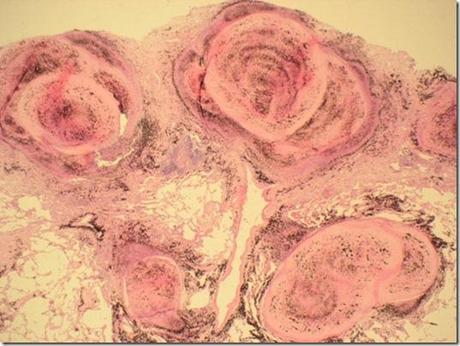
Image 2: H&E Stain, 40X
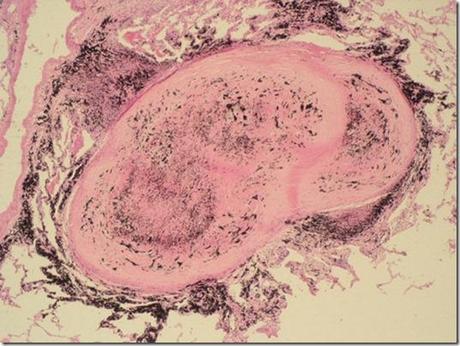
Image 3: H&E Stain 100X
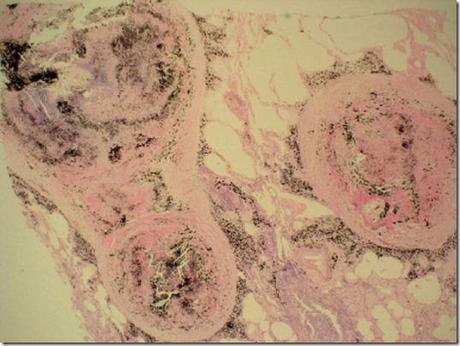
Image 4: H&E Stain 100x
Diagnosis:
1. Chest radiology shows multiple, round, well defined nodules, usually 0.5-2.0 cm in diameter, which may cavitate and resemble tuberculosis. (More on that in the next point!)
2. Lung function tests may reveal a mixed restrictive and obstructive ventilatory defect with a loss of lung volume. There may also be irreversible airflow limitation and a reduced DLCO.
3. Rheumatoid factor, antinuclear antibodies, and non-organ specific antibodies may be present in the serum.
Radiographic Appearance:
Summarizing from Dr. Caplan’s paper, this visual representation says everything eloquently:
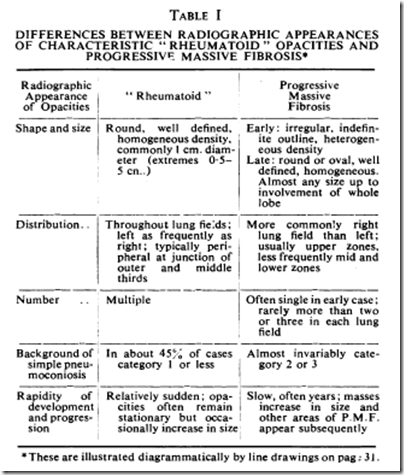
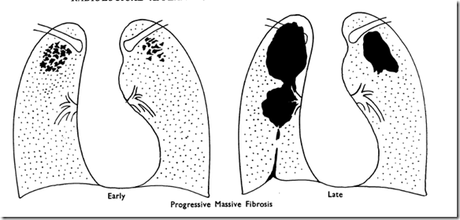
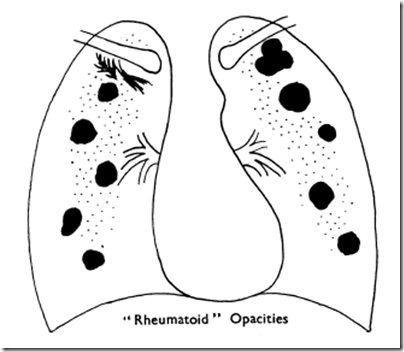
Differential Diagnosis:
Tuberculosis
Silicosis
Asbestosis
Pulmonary Nodules
Treatment:
1. Treatment for Rheumatoid arthritis in prescribed regimen with DMARDs, etc.
2. Exclude Tuberculosis, treat pulmonary lesions with steroids
3. Stop exposure to coal dust and silica.
4. Smoking cessation
Prognosis:
Although pneumoconiosis changes are amenable to treatment, however, the pulmonary fibrosis proceeds relentlessly as is the case with advancing Rheumatoid Arthritis. For all other purposes the prognosis of the case is directed by the disease activity and response to treatment of rheumatoid arthritis.
Sources:
1. Harrison’s Internal Medicine, 18th Ed
2. Wikipedia
3. Dr. Caplan’s Paper
4. Imperial College, Dept. of Medicine
5. Siegenthaler’s Differential Diagnosis in Internal Medicine
6. Review in European Journal of Internal Medicine
Image Credits:
Image 1: Koken Ltd, Japan
Images 2, 3, 4: Imperial College, Dept. of Medicine
